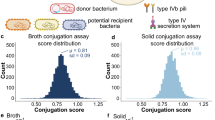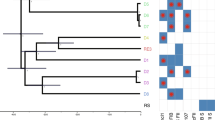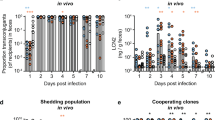Abstract
SEXUAL recombination occurs only at very low frequencies between Escherichia coli Hfr and Salmonella typhimurium recipients1–5. Frequencies of transfer of R factors6 from E. coli R+ to S. typhimurium R− are also very low (10−7/ donor)7. Thus a characteristic feature of the mating of E. coli with S. typhimurium is the low recipient ability of Salmonella strains. The low recipient ability of Salmonella was overcome by isolating fertile mutants by an indirect selection method in S. typhimurium LT-7 mut5. We reported that these fertile mutants are restrictionless and modificationless for foreign deoxyribonucleic acids (DNA) such as phage P22 DNA, R factors, F factor and bacterial chromosomes8. Eisenstark9 found that the frequencies of hybridization between E. coli Hfr and S. typhimurium LT-2 are increased by treatment of LT-2 recipients with N-methyl-N′-nitro-N-mtrosoguanidine (NG). We have found that two types of mutants of LT-2 selected by the transfer of an R factor from E. coli K-12 behaved, after elimination of the R factor with acridine orange, as good recipients of E. coli chromosomes, in the same way as was shown for K-12 (P1) by means of F-prime factor transfer10.
This is a preview of subscription content, access via your institution
Access options
Subscribe to this journal
Receive 51 print issues and online access
$199.00 per year
only $3.90 per issue
Buy this article
- Purchase on Springer Link
- Instant access to full article PDF
Prices may be subject to local taxes which are calculated during checkout
Similar content being viewed by others
References
Baron, L. S., Carey, W. F., and Spilman, W. M., Intern. Cong. Microbiol., Stockholm, 50 (1958).
Baron, L. S., Carey, W. F., and Spilman, W. M., Proc. US Nat. Acad. Sci., 45, 976 (1959).
Baron, L. S., Spilman, W. M., and Carey, W. F., Science, 130, 566 (1959).
Zinder, N. D., Science, 131, 813 (1960).
Miyake, T., Genetics, 47, 1043 (1962).
Watanabe, T., Bact. Rev., 27, 87 (1963).
Watanabe, T., and Fukasawa, T., J. Bacteriol., 81, 669 (1961).
Okada, M., Watanabe, T., and Miyake, T., J. Gen. Microbiol., 49, 888 (1968).
Eisenstark, A., Proc. US Nat. Acad. Sci., 54, 117 (1965).
Glover, S. W., Schell, U., Symonds, N., and Stacey, K. A., Genet. Res. Camb., 4, 480 (1963).
Watanabe, T., and Fukasawa, T., J. Bact., 81, 679 (1961).
Sanderson, K. E., and Demerec, M., Genetics, 51, 897 (1965).
Watanabe, T., and Okada, M., J. Bact., 87, 727 (1964).
Author information
Authors and Affiliations
Rights and permissions
About this article
Cite this article
OKADA, M., WATANABE, T. Isolation of Salmonella typhimurium Mutants with Increased Recipient Ability by the Use of R Factor. Nature 217, 854–856 (1968). https://doi.org/10.1038/217854b0
Received:
Issue Date:
DOI: https://doi.org/10.1038/217854b0
This article is cited by
-
Genetic and physical characterization of the ColIb plasmid using ColIb-R222 hybrids
Molecular and General Genetics MGG (1982)
-
Genetic control of defective cell shape and osmotic-sensitivity in a mutant of Salmonella typhimurium
Molecular and General Genetics MGG (1978)
-
Transduction by phage P1CMclr-100 inSalmonella typhimurium
Molecular and General Genetics MGG (1975)
-
The Nitrogen Fixation Genes
Nature (1972)
-
Effects of Cell Wall Polysaccharide on the Mating Ability of Salmonella typhimurium
Nature (1970)
Comments
By submitting a comment you agree to abide by our Terms and Community Guidelines. If you find something abusive or that does not comply with our terms or guidelines please flag it as inappropriate.



